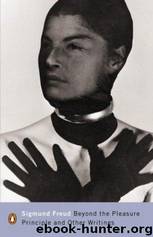Beyond the Pleasure Principle by Sigmund Freud

Author:Sigmund Freud [Freud, Sigmund]
Language: ita
Format: epub
ISBN: 0141184051
Publisher: Penguin Publishing
Published: 2009-02-05T23:00:00+00:00
IV
The Two Types of Drives
We have already made the point that our proposed division of the psyche into an id, an ego and a super-ego can only signify a real advance in our knowledge if it also proves to be the means to a deeper understanding and more accurate description of the dynamic relations at work in the life of the psyche. We have also come to appreciate that the ego is particularly subject to the influence of perception, and that in broad terms one can say that perceptions have the same significance for the ego that drives have for the id. At the same time, however, the ego is also susceptible to the influence of drives, just like the id – of which, of course, it is but part, albeit a specially modified one.
On the subject of drives, I have recently (in Beyond the Pleasure Principle) elaborated a view that I shall first recapitulate, and then use as the basis for the next stages of the argument. On this view, we need to distinguish two types of drives, one of which – the sexual drives, or Eros – is far more conspicuous, and far more accessible to our knowledge and understanding. It includes not only the uninhibited sexual drive itself and the goal-inhibited and hence sublimated drive-impulses deriving from it, but also the self-preservation drive that we perforce ascribe to the ego, and that at the very outset of our psychoanalytical work we had good reason to regard as contrasting sharply with the sexual object-drives. Demonstrating this second type of drive caused us considerable difficulty; our solution in the end was to regard sadism as representative of it. On the basis of theoretical considerations underpinned by biology, we posited a death drive charged with the task of causing animate organisms to revert to an inanimate state, whereas Eros pursues the goal of maximizing the complexity of life – and thereby of course preserving it – by an ever more catholic combination of the particles into which living matter had been fragmented. In pursuing their respective goals both drives behave in a strictly conservative manner, in that they seek the restoration of a state that was disrupted by the emergence of life. According to this view, the emergence of life is therefore the cause both of the urge to carry on living and, simultaneously, of the urge for death, while life itself is a battle and constant compromise between these two urges. Considered thus, the question as to the origin of life remains a cosmological one, while the question as to the purpose and intention of life is answered in dualistic terms.64
A particular physiological process is attributable – so the argument goes – to each of the two types of drive (anabolism and catabolism65); both drives are active in each and every piece of living substance, albeit in varying proportions, with the result that any such substance is capable of taking on the role of Eros.
Precisely how drives of the
Download
This site does not store any files on its server. We only index and link to content provided by other sites. Please contact the content providers to delete copyright contents if any and email us, we'll remove relevant links or contents immediately.
Rewire Your Anxious Brain by Catherine M. Pittman(18272)
Talking to Strangers by Malcolm Gladwell(12860)
The Art of Thinking Clearly by Rolf Dobelli(9901)
Mindhunter: Inside the FBI's Elite Serial Crime Unit by John E. Douglas & Mark Olshaker(8694)
Becoming Supernatural by Dr. Joe Dispenza(7829)
Change Your Questions, Change Your Life by Marilee Adams(7367)
The Road Less Traveled by M. Scott Peck(7271)
Nudge - Improving Decisions about Health, Wealth, and Happiness by Thaler Sunstein(7237)
The Lost Art of Listening by Michael P. Nichols(7154)
Mastermind: How to Think Like Sherlock Holmes by Maria Konnikova(6931)
Enlightenment Now: The Case for Reason, Science, Humanism, and Progress by Steven Pinker(6868)
Win Bigly by Scott Adams(6822)
The Way of Zen by Alan W. Watts(6286)
Daring Greatly by Brene Brown(6220)
Big Magic: Creative Living Beyond Fear by Elizabeth Gilbert(5347)
Grit by Angela Duckworth(5294)
Men In Love by Nancy Friday(4961)
Ego Is the Enemy by Ryan Holiday(4947)
Altered Sensations by David Pantalony(4862)
